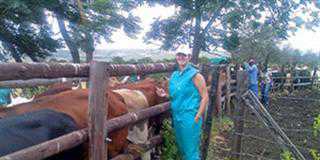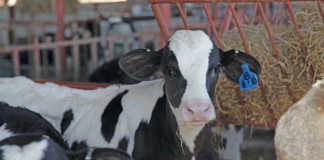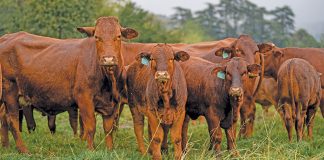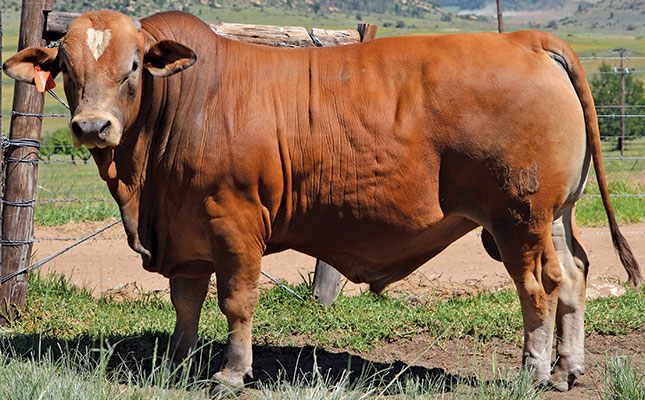
Photo: Simmentaler/Simbra Breeders Society’s Hoogland study group
The Simmentaler/ Simbra Hoogland Study Group’s Young Bull Day was held on the farm Ashtonvale near Bethlehem this year, and a total of 67 Simbras and 42 Simmentalers took part.
One Simbra breeder, Hendrik Grobbelaar, travelled from Tosca in North West, more than 600km away, to attend the event.
READ Better results with a single-breed herd on the Highveld
According to organiser Rick Dell, the bulls were between one and two years old and competed in four classes divided into the quarters of the year.
The Young Bull Day creates an opportunity for breeders to show animals without the high costs associated with conventional showing, he says.
“We provided for both halter-tame animals and animals from the veld in a ring similar to an auction ring.”
The bulls were evaluated by three of South Africa’s most experienced interbreed cattle judges: Fred Dell, Martin Seyfferdt and Marius Barkhuizen. Between them, they have more than 70 years’ experience as adjudicators.
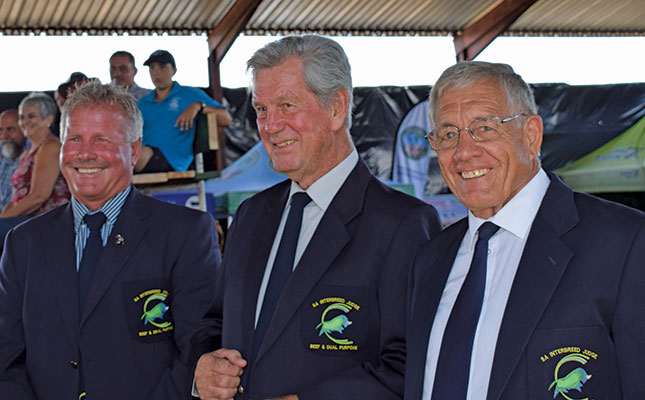
Structural correctness
According to Seyfferdt, the animals were assessed on structural correctness. A top bull, he stresses, needs to be strong and masculine, with good length and depth. Strong hindquarters and a well-balanced back and loins are also essential.
As some of the bulls were brought to the show directly from the veld, the judges did not take physical condition into account.
Judging of young bulls does not differ much from that of older bulls, although bulls can change between the age of, say, 15 months and two-and-a-half years. Pigmentation, testes and mouths, however, remain the same.
“We were, by and large, impressed with the quality of bulls presented at the Young Bull Day. However, we did pick up a few problems pertaining to masculinity and hocks here and there,” says Seyfferdt.
Breed with a specific goal in mind
He explains that the purpose of bull selection is to choose a bull that will maintain the good qualities of a cow herd and improve the poor qualities.
Breeders need to have a specific goal in mind when selecting a bull and must ensure that such a bull meets the requirements. A list of priorities could, for example, include fertility, length, width, muscling, growth, and milk production as well as coat and hair quality.
Seyfferdt warns against having an extensive list. The shorter a priority list, the faster the producer can select a bull and make progress in the herd.
READ Scientific selection in beef cattle breeding
Dell explains that an event such as the Young Bull Day makes it much easier for potential buyers, including commercial buyers, to make informed selection choices that will eventually add to the long-term sustainability and profitability of their farming concerns.
It creates the opportunity for breeders to compare animals and to learn from the evaluation criteria implemented by the judges.
According to him, the judges are exceptionally knowledgeable and have the ability to assess an animal in meticulous detail and explain how they arrive at a decision.
“This creates a chance for learning that will stand any breeder in good stead. The selection of the correct bull forms the foundation of any herd’s productivity and profitability,” says Dell.
He adds that the study group’s objective is to get more commercial and new farmers involved in the Young Bull Day.
Commercial beef cattle producers are the stud breeders’ most important client. The event also serves as an entry point for breeders who have never competed in the show ring before.
Continual improvement
Simmentaler breeder Jan van Biljon says breeders are constantly adjusting breed criteria to meet the requirements of the Southern African beef cattle industry.
Simmentaler breeders, for example, took a decision in 2017 to concentrate on bulls that are shorter in the leg and have improved muscling. This is important to ensure improved adaptability and optimal beef production per hectare.
READ Beef farming as part of a broader business
“The economic realities of beef cattle production in the country are such that producers simply cannot afford poorly performing animals,” says Van Biljon, who also serves as the president of the Simmentaler/Simbra Breeders’ Society.
“Initiatives such as the Hoogland Study Group’s event bring together the top Simmentaler and Simbra breeding material in the country. The more information that is disseminated to ensure informed selection choices, the better for the breed and the entire value chain.”
According to Simbra SA’s Standards of Excellence, the ideal animal should have the ability to produce a desirable carcass off the veld and be highly adaptable.
As a combination of Simmentaler and Brahman, the Simbra should clearly and identifiably exhibit the characteristic traits of these two breeds.
It should exhibit distinct purity of sex, have a good frame and a symmetrical outline, and stand squarely with hind legs well separated. It should also have sufficient length, breadth, depth, capacity and balance.
The winners
Simberg Riaan JS 1726, a bull belonging to Jamie Berger and Marius Nel of Coligny, took the laurels as the Supreme Champion Simmentaler bull.
The Reserve Supreme Champion was Rapole Rachner RAP 1766 belonging to Ivan Veldsman of Klerksdorp.
The Supreme Champion Simbra bull, Zarissa V VNW 1710C, was bred by Nerissa van Niekerk and Elzette Ferreira of Ficksburg. Riaan van Zyl’s Rotswand LZ 1731 was the Reserve Supreme Champion Simbra bull.
The judges described the champion bulls as masculine, with excellent back quarters, impressive length and depth, and well-developed legs and testes.
Van Niekerk says she will definitely take part in next year’s Young Bull Day, as the event makes it possible for more breeders to exhibit their animals and enables breeders to network.
“The quality of the bulls was outstanding. What impressed me in particular about the Simbra bulls was the excellent balance between the two base breeds. These young bulls underscored the genetic integrity of the national herd and the adherence to breed standards. It bodes well for the future of the breed.”
Nel says it is clear from the excellence of the bulls that stud breeders know what type of animal the South African beef cattle industry needs: strong, hardy, medium-framed bulls for the production of heavy weaners.
“The bulls at the Young Bull Day represented superior genetic value,” she adds.
Phone Riette Dell of the Hoogland Study Group on 083 766 5552.









